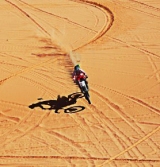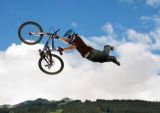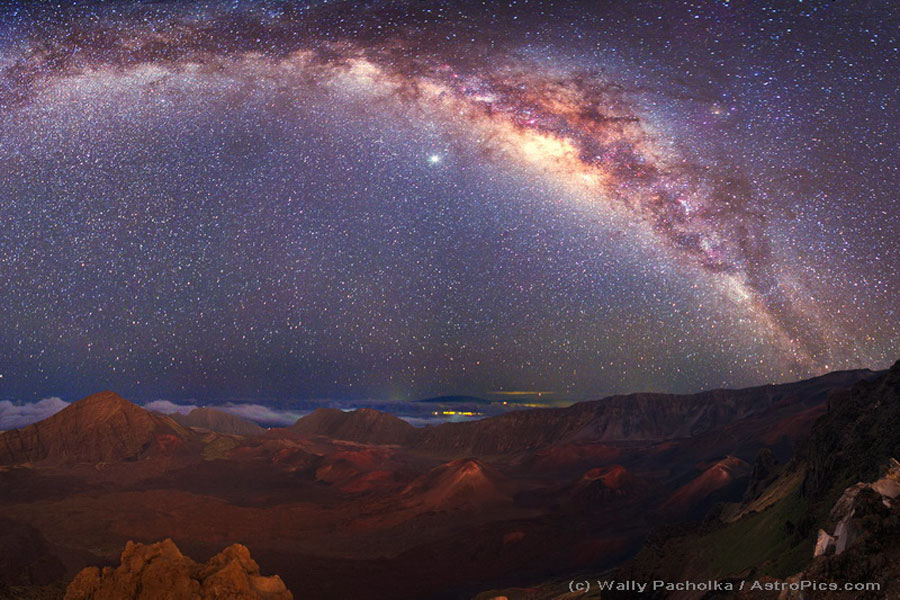- Forum
- General Discussion | Introductions | Off Topic Forum
- Photography General Discussion
- Where is the best place to photograph the milky way?
Where is the best place to photograph the milky way?
-
 Topic Author
Topic Author
- Joe Photo Daddy
- Lone Wolf
- D80
- Followers: 71
- Posts: 237
-
Points:
467
Post #300507
-

- KCook
- Photo Elder
-
- Canon EOS 50D and Olympus E-P5
- Followers: 1325
- Posts: 5410
-
Points:
32913
Post #300515
Rule 2: Near the Earth's equator. This allows you to view most of the extent of the Milky Way.
Rule 3: Away from airline routes. Airplane light trails do not help matters.
Rule 4: Higher altitude is better. Low altitude air is denser, carries more crude, resulting in less transparency.
Rule 5: Desert is better. Similar to Rule 4, only this time trying for less moisture content.
Rule 6: Whatever nice foreground you can find. Milky Way shots showing the horizon are generally prettier than those with only the sky and Milky Way.
Kelly Cook
-

- StephanieW
- Photography Hooked
-
- Canon 30D
- Followers: 11
- Posts: 852
-
Points:
0
Post #300647
If there is no observatory nearby, the above comment is perfect.
-

- effron
- Newbie
- Followers: 1623
-
Points:
129640
-

- Ian Stone
- Photo Elder
-
- Nikon D800 and Z6
- Followers: 1483
- Posts: 5023
-
Points:
39274
-

- Ian Stone
- Photo Elder
-
- Nikon D800 and Z6
- Followers: 1483
- Posts: 5023
-
Points:
39274
Post #300695
"Explanation: Have you ever seen the band of our Milky Way Galaxy? In a clear sky from a dark location at the right time, a faint band of light becomes visible across the sky. Soon after your eyes become dark adapted, you might spot the band for the first time. It may then become obvious. Then spectacular. One reason for a growing astonishment might be the realization that this fuzzy swath contains billions of stars and is the disk of our very own spiral galaxy. Since we are inside this disk, the band appears to encircle the Earth. Visible in the above image, high above in the night sky, the band of the Milky Way Galaxy arcs. The bright spot just below the band is the planet Jupiter. In the foreground lies the moonlit caldera of the volcano Haleakala, located on the island of Maui in Hawaii, USA. A close look near the horizon will reveal light clouds and the dark but enormous Mauna Kea volcano on the Big Island of Hawaii. If you have never seen the Milky Way band or recognized the planet Jupiter, this year may be your chance. Because 2009 is the International Year of Astronomy, an opportunity to look through a window that peers deep into the universe may be coming to a location near you."
apod.nasa.gov/apod/ap090127.html
-

- Ian Stone
- Photo Elder
-
- Nikon D800 and Z6
- Followers: 1483
- Posts: 5023
-
Points:
39274
-

- EOS_Fan
- Photography Hooked
-
- Canon EOS 60D
- Followers: 162
- Posts: 642
-
Points:
6154
Post #300803
Ian Stone wrote: More:
"Explanation: Have you ever seen the band of our Milky Way Galaxy? In a clear sky from a dark location at the right time, a faint band of light becomes visible across the sky. Soon after your eyes become dark adapted, you might spot the band for the first time. It may then become obvious. Then spectacular. One reason for a growing astonishment might be the realization that this fuzzy swath contains billions of stars and is the disk of our very own spiral galaxy. Since we are inside this disk, the band appears to encircle the Earth. Visible in the above image, high above in the night sky, the band of the Milky Way Galaxy arcs. The bright spot just below the band is the planet Jupiter. In the foreground lies the moonlit caldera of the volcano Haleakala, located on the island of Maui in Hawaii, USA. A close look near the horizon will reveal light clouds and the dark but enormous Mauna Kea volcano on the Big Island of Hawaii. If you have never seen the Milky Way band or recognized the planet Jupiter, this year may be your chance. Because 2009 is the International Year of Astronomy, an opportunity to look through a window that peers deep into the universe may be coming to a location near you."
apod.nasa.gov/apod/ap090127.html
I feel so small!
-

- Roblane
- Photography Hooked
-
- Nikon D600
- Followers: 117
- Posts: 505
-
Points:
2536
Post #301147
EOS_Fan wrote:
Ian Stone wrote: More:
"Explanation: Have you ever seen the band of our Milky Way Galaxy? In a clear sky from a dark location at the right time, a faint band of light becomes visible across the sky. Soon after your eyes become dark adapted, you might spot the band for the first time. It may then become obvious. Then spectacular. One reason for a growing astonishment might be the realization that this fuzzy swath contains billions of stars and is the disk of our very own spiral galaxy. Since we are inside this disk, the band appears to encircle the Earth. Visible in the above image, high above in the night sky, the band of the Milky Way Galaxy arcs. The bright spot just below the band is the planet Jupiter. In the foreground lies the moonlit caldera of the volcano Haleakala, located on the island of Maui in Hawaii, USA. A close look near the horizon will reveal light clouds and the dark but enormous Mauna Kea volcano on the Big Island of Hawaii. If you have never seen the Milky Way band or recognized the planet Jupiter, this year may be your chance. Because 2009 is the International Year of Astronomy, an opportunity to look through a window that peers deep into the universe may be coming to a location near you."
apod.nasa.gov/apod/ap090127.html
I feel so small!
I was going to say the same thing! These photos are so breathtaking
-

- Jeanne Merlo
- Snapobsessed
-
- Nikon D300
- Followers: 48
- Posts: 335
-
Points:
651
Post #301529
Ian Stone wrote: More:
"Explanation: Have you ever seen the band of our Milky Way Galaxy? In a clear sky from a dark location at the right time, a faint band of light becomes visible across the sky. Soon after your eyes become dark adapted, you might spot the band for the first time. It may then become obvious. Then spectacular. One reason for a growing astonishment might be the realization that this fuzzy swath contains billions of stars and is the disk of our very own spiral galaxy. Since we are inside this disk, the band appears to encircle the Earth. Visible in the above image, high above in the night sky, the band of the Milky Way Galaxy arcs. The bright spot just below the band is the planet Jupiter. In the foreground lies the moonlit caldera of the volcano Haleakala, located on the island of Maui in Hawaii, USA. A close look near the horizon will reveal light clouds and the dark but enormous Mauna Kea volcano on the Big Island of Hawaii. If you have never seen the Milky Way band or recognized the planet Jupiter, this year may be your chance. Because 2009 is the International Year of Astronomy, an opportunity to look through a window that peers deep into the universe may be coming to a location near you."
apod.nasa.gov/apod/ap090127.html
What gear was used to take that photo?
-

- Rudy Sosa
- Snapobsessed
-
- Canon 5D Mark III
- Followers: 74
- Posts: 319
-
Points:
2350
-

- KCook
- Photo Elder
-
- Canon EOS 50D and Olympus E-P5
- Followers: 1325
- Posts: 5410
-
Points:
32913
-

- MajorMagee
- Photography Hooked
-
- E-PL1, E-PL2, E-PM1, E-P5
- Followers: 13
- Posts: 739
-
Points:
0
-

- Sawyer
- Master of the Lens
-
- Canon 5D Mark II
- Followers: 248
- Posts: 1862
-
Points:
13181
- Forum
- General Discussion | Introductions | Off Topic Forum
- Photography General Discussion
- Where is the best place to photograph the milky way?
Latest Reviews
The Fujifilm XT5 is a 40MP mirrorless camera capable of 6.2K video at 30p. With those specs, it’s an ideal choice for photographers needing a camera to pull double duty for imaging and video.
The Canon EOS R100 is an entry-level mirrorless camera introduced in 2023. But just because it’s an entry-level camera doesn’t mean it’s a bare-bones camera. Find out why in this review!
Nikon’s retro-looking Nikon Zfc is anything but retro. Under its classic body is a host of features and amenities that make it a worthwhile compact mirrorless camera for 2024.
The Canon EOS R50 is one of the newest R-system cameras from Canon. Is it worth your money? Find out all the details you need to know in this comprehensive review.
Forum Top Posters
-
1TCav 7 posts
-
2CharleyL 5 posts
-
3Sawyer 5 posts
-
4db3348 3 posts
-
5Scotty 3 posts
-
6Tristan R 3 posts
-
7Hassner 3 posts
-
8AstralArti... 3 posts
-
9Randy Shaw 3 posts
-
10Shadowfixe... 2 posts
Latest Articles
The best beginner camera isn’t the same for everyone. That means having choice is of the utmost importance. In this guide, explore five excellent beginner camera options for 2024 and beyond.
Child portrait photography is a unique undertaking requiring special skills and talents to get the best results. Start mastering this photography niche with these essential tips!
The Fujifilm XT5 is a 40MP mirrorless camera capable of 6.2K video at 30p. With those specs, it’s an ideal choice for photographers needing a camera to pull double duty for imaging and video.
Using leading lines in photography helps improve the composition by drawing viewers in and leading their eye from the foreground to the background. Explore some fine examples of this in this guide!
The Insta360 has one of the best lineups of action cams and 360-degree cameras. With these Insta360 accessories, you can elevate your photography and videography game!
Creating impactful photos of landscapes depends on many factors, not the least of which is your talent behind the lens. This guide explores other elements required for the best product.
The Canon EOS R100 is an entry-level mirrorless camera introduced in 2023. But just because it’s an entry-level camera doesn’t mean it’s a bare-bones camera. Find out why in this review!
Are you ready to upgrade your camera? Before buying new, you might consider the value of purchasing used gear to save money.

















